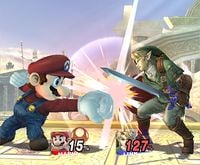Damage: Difference between revisions
m (grammar) |
MHStarCraft (talk | contribs) No edit summary |
||
| Line 1: | Line 1: | ||
{{ArticleIcons|ssb=y|ssbm=y|ssbb=y}} | {{ArticleIcons|ssb=y|ssbm=y|ssbb=y}} | ||
[[Image:damagepercent.jpg|thumb|right|[[Mario]] damaging [[Link]] in ''Brawl''.]] | [[Image:damagepercent.jpg|thumb|right|[[Mario]] damaging [[Link]] in ''Brawl''.]] | ||
'''Damage''' is | '''Damage''' is the basic measure of how vulnerable a player is to the [[knockback]] of attacks. At low damages, the player cannot be knocked back very far, and can only be thrown off-stage by the game's most powerful attacks. At high damages, the player is knocked back considerably by most attacks, and is at increasing risk of being [[KO]]'d. | ||
Damage starts at 0% and can rise all the way up to 999%. Though damage is displayed as a percent, getting to 100% does not mean a character is doomed - the number itself is somewhat arbitrary. Damage is measured as an integer in ''SSB64'' and a decimal number in ''SSBM'' and ''SSBB''; a damage with a decimal part is rounded down when displayed. | Damage starts at 0% and can rise all the way up to 999%. Though damage is displayed as a percent, getting to 100% does not mean a character is doomed - the number itself is somewhat arbitrary. Damage is measured as an integer in ''SSB64'' and a decimal number in ''SSBM'' and ''SSBB''; a damage with a decimal part is rounded down when displayed. | ||
Revision as of 08:12, May 11, 2012
Damage is the basic measure of how vulnerable a player is to the knockback of attacks. At low damages, the player cannot be knocked back very far, and can only be thrown off-stage by the game's most powerful attacks. At high damages, the player is knocked back considerably by most attacks, and is at increasing risk of being KO'd.
Damage starts at 0% and can rise all the way up to 999%. Though damage is displayed as a percent, getting to 100% does not mean a character is doomed - the number itself is somewhat arbitrary. Damage is measured as an integer in SSB64 and a decimal number in SSBM and SSBB; a damage with a decimal part is rounded down when displayed.
Each attack deals a set amount of damage, which is then modified by things such as Stale-Move Negation before the target is launched. An attack that does no damage will not cause targets to flinch and not produce a regular hit sound, although it will still cause knockback. The damage an attack deals is a significant factor in how much knockback it causes.
The following things are affected by damage:
- Knockback - As a character gets more damage, they fly further when hit. Certain attacks have set knockback, and don't apply.
- Grab time - Characters at high damage can be grabbed for longer periods of time.
- Status time - Generally, characters with higher damage are vulnerable for longer from a status effect (such as sleeping). The exception is being stunned though a shield breaking - the more damage a stunned character has, the faster they can recover.
- Ledge recovery - At 100% and up, a character's ledge animations change, becoming more sluggish and providing more invincibility frames. The slower attack also deals more damage.
- Hoop damage - Characters will not accumulate hoop damage at 150% damage or more.
- Jet Hammer - Like hoop damage, King Dedede will not be damaged by charging this attack when he has 150% or more damage.
- Lucario's attack power - The more damage Lucario has, the more damage his aura-based attacks do. The power is at "normal" when Lucario is at 75%, while it stops decreasing at 20% and caps at 170%.
- Pikmin latch time - Pikmin release a character faster at higher damages.
- A Team Healer's healing power - The more damage the target has, the more damage the item heals.
- Swim time - Higher-damaged characters have less time to swim before panicking, the shortest swim time being at about 90% and up.
- Donkey Kong's Forward throw - The more damage the grabbed character has, the longer they can be carried, similar to the grab time function.
Damage meter
The damage meter displays the damage percentage a character has accumulated from attacks, as well as the character's universal symbol and number of stock remaining (in non-stock modes, it displays as 1 "stock"). Damage meters are displayed at the bottom of the screen during gameplay. The color of the symbols is based on the player's controller port or team color and is grey for computer players.
In Super Smash Bros. and Melee, the identity of a character's damage meter, if not belonging to someone with a unique symbol (such as Yoshi or Ness), is made obvious by the stock counter bearing the image of the character's face. Because this is tied into the number of stocks remaining, if a character is defeated (and therefore has no stock images showing), one cannot always tell at a glance who the defeated character is. This is changed in Brawl, where a somewhat large image of the character and their name are used alongside the percentage display; the stock counter is simply a row of dots. The image is normally opaque, but it becomes translucent if a character is standing "behind" it.
